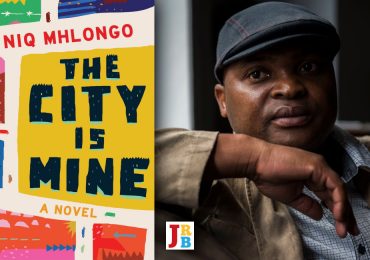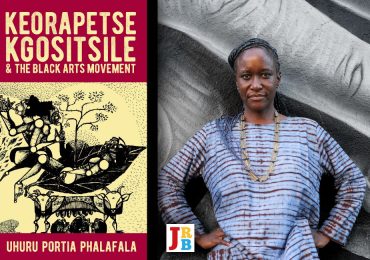The JRB presents an excerpt from Trevor Ngwane’s forthcoming book Amakomiti: Grassroots Democracy in South African Shack Settlements.

Amakomiti: Grassroots Democracy in South African Shack Settlements
Trevor Ngwane
Jacana Media, 2021
Thembelihle Settlement: A Vision of Hope
Bhayiza Miya spent three months in Sun City, also known as the Diepkloof Prison, supposedly ‘awaiting trial’ after being arrested for leading a major protest action in Thembelihle, an informal settlement in Lenasia, south of Johannesburg. This was not the first time he had been a victim of state repression for involvement in the struggle of this community for housing, services and a decent life. Twenty years before this protest which sent him to jail, he had lost all his front teeth from a rubber bullet fired at point blank range by a policeman in an attempt to quell the community’s opposition to forced removals. In between these bad experiences at the hands of the ANC state’s law enforcement agencies, Miya never stopped being an active member and leader of the Thembelihle Crisis Committee (TCC), the social movement organisation that led both the struggle against relocation two decades ago and the month-long protest action for housing, electricity and other services that turned Miya into a jailbird.
For two decades, the TCC has been at the forefront of the Thembelihle community’s struggle for recognition (‘proclamation’) of their informal settlement and provision of basic services. The TCC operates in the same space as an ANC committee and a ward committee. Researchers have struggled with how to characterise this committee because of its unique features and the peculiarities of the political process in this community. The socialist-oriented committee regularly leads the Thembelihle community in protest, and is arguably a main contender for local power and influence, challenging the political hegemony of the ANC government and party by pressing forward the community’s demands for development. In this chapter, I will examine the dynamics behind the emergence of the TCC and the factors that shaped its politics. I will do this by tracing the evolution of the committees and organisations that operate in this settlement from past to present. I will explore the argument that it is the TCC’s grounding in the Thembelihle community’s radical participatory democratic practice that has allowed it to keep in touch with the needs and views of its constituency, making it possible for it to play a more or less dominant role in local politics for about two decades.
The Place of Good Hope
Thembelihle is an informal settlement situated cheek by jowl with Lenasia, a suburb that was designated ‘Indian’ under apartheid’s Group Areas Act. Lenasia is located 30 kilometres south of Johannesburg’s central business district. Thembelihle’s shacks lie between Extensions 9, 10 and 14 of Lenasia. There are between 7,000 and 8,000 households cramped into 6,775 shacks, with 3,597 being primary dwellings and 3,178 occupied by sub-tenants. The settlement layout is a square grid town planning pattern with many of the roads wide enough to allow easy access for pedestrians and motor vehicles. The roads are unpaved except Capella Street, the access road running through the settlement north to southeast, and another road that runs east to west through the southern part of the settlement. There is a water tap in every yard, but the water pressure is low and many taps run dry during peak hours. There are no flush toilets, you have to dig your own pit toilet; the government recently installed some ventilated pit latrines, but the project was not completed. Communal and recreational facilities are almost nonexistent except for a dusty football ground where Bhayiza Miya is often to be seen—he is a keen soccer player and administrator. In the 1990s, local schools were refusing to accommodate students from Thembelihle, but they agreed after a ‘Right to Education’ campaign spearheaded by the TCC and supported by the University of Johannesburg’s Centre for Education Rights and Transformation.
Community meetings take place at SA Block, two brick buildings that were once a brick-making factory. The complex consists of run-down offices and a monumentally long ‘hall’ that was built for other purposes and whose interior is dark because of its small windows and cavernous nature. In front of the buildings is a parking lot that serves as the venue for Thembelihle’s open-air community meetings. Meetings also take place at the taxi rank toward the north of the settlement. The street running east to west near SA Block is Thembelihle’s main and busiest street. It is a long road along which there are rows of shacks on either side. About half of these shacks operate various small businesses, taking advantage of the human traffic. These spaza (informal) shops sell basics such as cool drinks, bread, paraffin, meat and beer. A few artisan-type businesses are in operation, such as a shoemaker, tailor and hair salon. About five years ago, a mall was built a kilometre or two away to the east of the settlement that provides a wider range of goods, entertainment and job opportunities for the locals.
An important factor in the life of the community has been the installation of electricity in the area by the residents themselves. Most shacks now enjoy electricity which is self-connected and against the laws of the municipality. Self-connection started slow, but really took off around 2010, when reputedly everyone wanted to watch the World Cup on television. At first, comrades connected to the few high-mast ‘Apollo’ street lights in the area, but this tampering cast the settlement into darkness. Connections are now made to the electrical transformers serving Lenasia. Complaints by Lenasia residents and the practice by City Power, the municipal electricity company, of periodically cutting and confiscating the people’s cables invariably provokes street protests, such as the one that happened on 25 June 2014. A winning tactic employed by Thembelihle residents is retaliating by sabotaging Lenasia’s electricity supply, plunging parts of the suburb into darkness—a devious trick they learned from informal settlement comrades in Protea South, Soweto. Thembelihle residents feel that they are entitled to the electricity. One argument proffered to justify self-connections is that people have died as a result of shacks burning down because of the use of unsafe energy. The authorities claim that they cannot install electricity because the township is not proclaimed and their policy is to relocate the people:
Oh yes, we have electricity, can you see how smart we are? So we all have electricity cables underneath and others dug deeper, so that no one can steal them. It is a real cable and it works well … The last time I used gas, it was back in 2011, if not 2010.
The [September 2013] protest helped us because we have electricity now. The Indians know very well that this is not ‘land Asia’, this is Thembelihle. They know very well that when they cut off our electricity, the mall also gets its power cut off, too.
At 59 per cent, the rate of unemployment in Thembelihle is higher than Statistics South Africa’s 38.8 per cent expanded definition of unemployment. Many Thembelihle workers are precariously employed, earning low wages and with little job security. There is a perception that local Indian employers pay less. Many workers can walk to work, but there are kombi taxis to help you reach Lenasia Central Business District, which is seven kilometres away. Thembelihle is a poor working-class residential area because many people are reliant on or aspire to employment as their main source of income. The government social grants are probably an important source of income. Working appears to be an important aspect of the lives and identities of Thembelihle residents, as the following quote from a man who survives on collecting scrap for recycling and once owned a spaza shop suggests when he looks back on his life spent in the area: ‘This place taught me how to be a man, moreover I was working at that time.’
Ithemba means ‘hope’ in isiZulu, and elihle means ‘good’ or ‘beautiful’. ‘Thembelihle’ therefore means ‘a place of good hope’. The name was given to the settlement early in its life by the first committees operating in the area, to convey the sense of hope that gripped the residents then. The place was ‘baptised’ after an episode of violent conflict in the area. The name thus represents a tenacious hanging on to the dream of building a new community against all odds, including internal fights and external threats. It seems that this determination to realise the dream became an important element of the Thembelihle collective identity:
In 1990, this place was further established, [but] up until Section F [came into being], then more chaos erupted. There were disagreements and no understanding. We ended up going to the [ANC] Region. At the Region, we talked and discussed things … We were told to name this place, and then Bab’ uMakopo said: ‘We have a beautiful hope that this place will be beautiful’—that is how this place was named Thembelihle.
But as you move around the area today, there are empty stands where the tenants have moved away to Lehae, a new housing development about four kilometres away to which people are being ‘voluntarily’ relocated by the authorities. It appears as if there is erosion of this hopeful identity:
[We have] to think questions of identity, either social or individual, not in the wake of their disappearance but in the wake of their erosion, of their fading, of their not having the kind of purchase and comprehensive explanatory power they had before …
The empty spaces and absent neighbours arguably represent the power of the state to impose its decisions on the people and its refusal to develop the settlement. It also represents the surrender of hope and the stripping of the place-based collective identity as people relent and give up on keeping on living in their beloved Thembelihle in exchange for a brick ‘RDP’ house in the new area. The battle is not altogether lost, because an overwhelming majority continue to live in Thembelihle and, as we will see below, the government has very recently relented on its relocation policy:
I don’t want to leave a place I’m used to, to go and start all over again. Have a new neighbour that I don’t even know. Where I live I know all my neighbours and we are used to each other.
But the hope of in situ development is being eaten away as if by termites each time a family pulls down its shack and moves to Lehae. It is as if the territorial stigmatisation or ‘blemish of place’ that the community had managed to largely conquer through its resistance to forced removal is being resuscitated and the process of ‘dissolution of place’ has begun; authorities will vilify and stigmatise ‘slums’ until the residents themselves tragically internalise this, resulting in: ‘the loss of a humanised, culturally familiar and socially filtered locale with which marginalised populations identify, and in which they feel at “home” and in relative security.’ Hence the old guard’s lament:
You see our community used to be very strong but now we are very weak because as many as we are, we no longer have hope for our place like before.
I wish this community can be developed, we love this place.
~~~
- Trevor Ngwane is a scholar activist who spent twenty years as a full-time organiser in South African trade unions, community organisations and social movements before and after the defeat of apartheid. He obtained his PhD in Sociology at the University of Johannesburg where he now teaches and conducts research.
Publisher information
Can people who live in shantytowns, shacks and favelas teach us anything about democracy? About how to govern society in a way that is inclusive, participatory and addresses popular needs? This book argues that they can.
In a study conducted in dozens of South Africa’s shack settlements, where more than nine million people live, Trevor Ngwane finds thriving shack dwellers’ committees that govern local life, are responsive to popular needs and provide a voice for the community. These committees, called ‘amakomiti’ in isiZulu, organise the provision of basic services such as water, sanitation, public works and crime prevention especially during settlement establishment.
Amakomiti argues that, contrary to common perception, slum dwellers are in fact an essential part of the urban population, whose political agency must be recognised and respected. In a world searching for democratic alternatives that serve the many and not the few, it is to the shantytowns, rather than the seats of political power, that we should turn.





